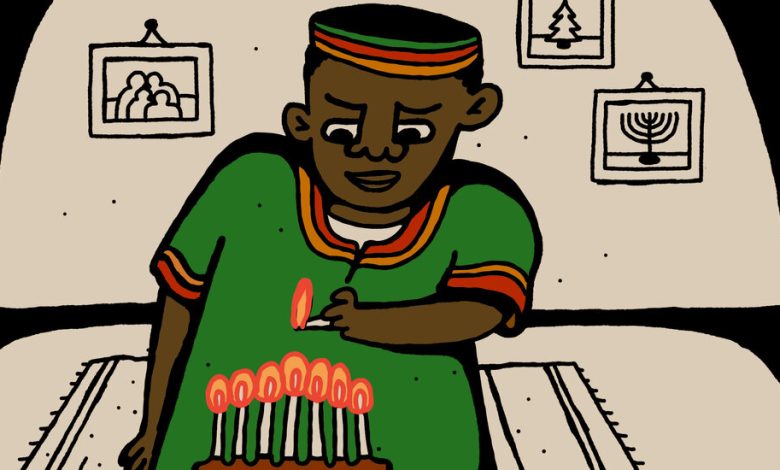Yes, Kwanzaa Is Made Up. That’s Why It’s Great

Forget April: Inmiddle school, November was always, inevitably, the cruelest month for me. Starting around Thanksgiving, my friends would gather in the locker room after gym class to consult one another on the best strategies for the holiday season. Crouched over Best Buy and Circuit City catalogs, they would argue the merits of the PlayStation 2 versus the Xbox. Should they beg for the latest edition of NBA 2K, a game that would be obsolete within nine months? Or Halo?
I envied them. For me, there would be no gifts — at least, no gifts that I actually wanted. My mom, a child of both the 1970s and Southern Californian fluidity, had converted to Islam and stopped celebrating Christmas years prior — not because of her new faith but because she was fed up with that holiday’s materialism. She regarded Christmas with the same suspicion she felt toward other mainstream American holidays. We didn’t celebrate Thanksgiving either, or Halloween; I suspect the only reason we observed Valentine’s Day was that my mom liked to receive flowers every now and again. As I understood it, we scorned these days because they asked us to subscribe to “white” cultural stories about how the world worked, and we didn’t want any part of that. Why would we? We had our own holiday: Kwanzaa.
Even by the standards of America, a country that birthed a whole new branch of Christianity in the last 200 years, Kwanzaa is a baby. Founded in 1966 by a Southern Californian Black Power activist named Maulana Karenga, Kwanzaa was meant to be the bedrock of a new cultural nationalism that appealed to Black people increasingly disillusioned by the post-Civil Rights Movement world. At a time when Black people were finding ways to express their independence from white cultural norms — trading “slave names” for African (or maybe just African-inspired) ones, growing their hair out, donning Ghanaian kente cloth — Kwanzaa was an attempt to craft a distinctly Black consciousness by providing an alternative to a “white” Christmas.
Rooted in sometimes artful but often ham-handed borrowing of various African traditions, the holiday is one of the many bridges Black Americans tried to build between themselves and the African homeland of their imagination. Kwanzaa unfolds across seven nights, each of them dedicated to one of seven principles, among them unity, self-determination and collective work. In some cases, children are given gifts on each night, with one catch: The gifts have to be educational in nature. On the sixth day, the holiday culminates in a celebratory feast.
My mom loved this. Every year, she would unpack the kente cloth; the kinara (a seven-pronged candelabra similar to a menorah); red, black and green candles; the plastic fruit and cornucopia that represented the imagined bounty of the homeland. Every night, my younger brother, my parents and I would gather before the kinara to light a candle while reciting the holiday’s principles. On the sixth day, my father would smoke meat in our backyard while my mom cooked something akin to a Thanksgiving dinner.
Was all of that admirable? Yes. Did I, a child, find much inspiration in it? No. Watching my friends and classmates get the video games I wanted but would not receive fueled a sense that I was the worst possible thing a middle-school child can be: different. I didn’t want to be different. I wanted a video game. (One year, I remember that my mom answered my pleas with a PlayStation “Jeopardy!” game.)
When I told other kids that my family celebrated Kwanzaa, I was met with slack-jawed incomprehension or, worse, gimlet-eyed ridicule, before being asked the inevitable question: Isn’t that a made-up holiday? And when I went away to college in New York, I found that Kwanzaa was something of a joke among my classmates. The trappings of Pan-African culture — the dashikis and kufis that once felt ubiquitous at home — were objects of skepticism. Kwanzaa’s status as “made up” was a charge I couldn’t then counter and didn’t care to.
As I got older, my family celebrated Kwanzaa with dwindling regularity. Family died, or squabbled and fell out. Eventually, I stopped returning to Los Angeles on holiday breaks. By my mid-20s, I was more likely to attend Passover seders than Kwanzaa celebrations.
Maybe it was through those seders that I arrived at an appreciation of Kwanzaa. My friends were leftist Jews who altered Passover’s rituals to reflect their own political commitments. It was nothing, to them, to graft new customs onto an old tradition. Their prayers called to mind the recitations of Kwanzaa’s seven principles. These were all, it seemed to me, ways not just to celebrate the past, but to create the future that you wanted in the world.
In a world obsessed with returning to pasts that are always better than our present, I see a new value in Kwanzaa. There’s something uniquely American (and, I think, Southern Californian) in both its wanton borrowing from existing tradition and its naked admission of artificiality. It’s a holiday meant to celebrate what a people hoped to become — free, in community with one another, independent — not just a rote invoking of the past, something you do because your ancestors did it. I love that: the idea, or fantasy maybe, that moving into the future means taking only what is useful from the past, rather than lugging the entire thing around with you.
Ismail Muhammad is a story editor at the magazine.
